 |
| Home for Bats, Raccoons, Squirrels, Bat's or Raccoon's Feces (Guano) Removal. |
| Zip Code Area Serviced |
| Counties We Provide Service For |
| About Us and Contact Info |
| Bats Found in Ohio |
| Bat Exclusion |
| Guano Removal aka Bat (Feces) Poop |
| Opossums Information on Size, Breeding, Habits, and Diseases |
| Raccoons, Habits, Breeding, Size, Raccoon Diseases, Raccoon Trapping |
| Skunks, Odors, Habit, Breeding, Size, Trapping |
| Squirrels, Squirrel Diseases, Removal, Habits |
| Beavers |
| Chimney & Deck Screening |
| Trapping |
| Common Questions Asked |
| Cats, Dogs and Your Local Wardens |
| Do Repellents Really Work?? |
| My Family's 1st WildlifeTrapper & Home Owner's Insurance |
| Info On Raccoons, Bats, Squirrels, Etc..,Size, Weight, Breeding, Etc... |
| Bats Myths or Facts |
| Infectious Diseases of Wildlife |
| "Ken Kritter Korner" |
| NEW SERVICE Bees and Hives Info |
|
|
 |
During
the early days on the wild frontier, the beaver was a creature to be prized and was sought after for its fur. Well, those
days have long since past and now the beaver is becoming a major pest causing damage to property and the environment. Due
to the decline in demand for its fur, the beaver is no longer heavily pursued and its population has swelled. Our local rivers
and waterways are no exception.
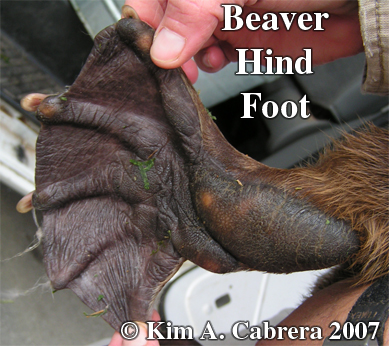
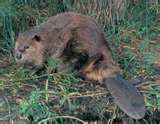
|
 |
|
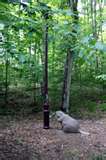
Beavers today are found throughout all of the North American continent. Here
in Ohio, biologists believe beavers are present in almost every county. Given their large size and the limited amount of time
they spend away from the protection of water, adult beavers have relatively few natural predators. Because of the low natural
mortality and an abundance of suitable habitat, Ohio's resident beaver population currently is expanding, but the exact statewide
population has not been estimated.
Because human populations continue to expand into more rural areas where
beavers are more prevalent, humans are encountering beavers more often than ever before. Thus, as beaver populations continue
to expand into new habitats, many residents will be looking for ways to control the damage caused by beavers.
Physical damage caused by beavers in the Southeast is estimated in the millions
of dollars annually. Examples of this damage include timber and agricultural crop loss, damage to roads, septic systems and
other property by flooding, and destruction of ornamental plants used in landscaping.
A
beaver may consume up to 20-30 oz. of food per day (about equal to the bark and smaller branches of a 2-inch diameter tree
every 2 days). They consume a wide variety of aquatic plants and trees, including pine, red cedar, willow, alder, tulip poplar,
red maple, dogwood, sweet gum, beech, and others that grow near water. During spring and summer, beavers consume mostly grasses,
sedges, rushes, some farm crops (e.g., soybeans, corn), and the succulent new growth of small bushes. As winter approaches,
they switch more to woody material
 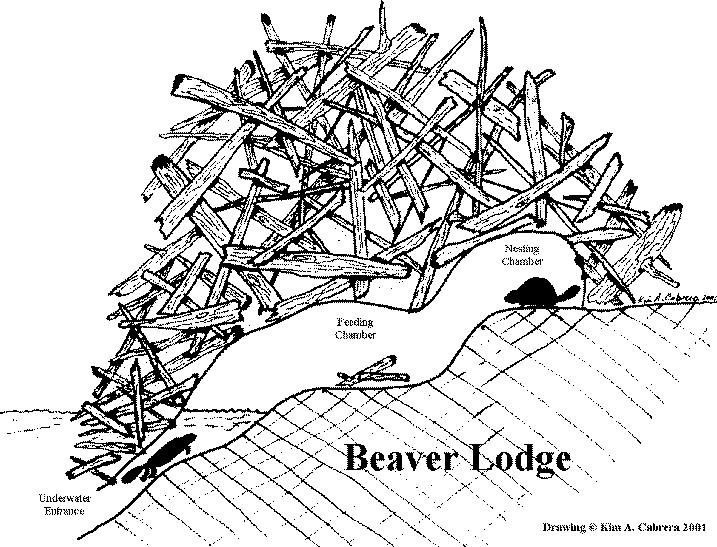
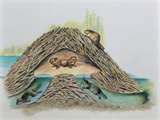
Lodges are dome-shaped are built in deep water. Lodges are built
with wide bases, sometimes up to 20 feet wide. The top can stand ten feet high. Entrances are under water and the beavers
swim away from the lodge before surfacing. Dams and lodges are constructed of interwoven branches. The water behind the dam
generally is backed up to a depth of four to six feet. Dams can be wide, often five feet or more. The length of the dam depends
upon the width of the stream. Beaver ponds provide habitat for various species of fish, and other mammals, such as otters,
that feed on the fish. Ospreys and other birds will nest in the dead snag trees that are killed by the flooding caused by
the beaver pond. These birds feed on the fish in the pond.


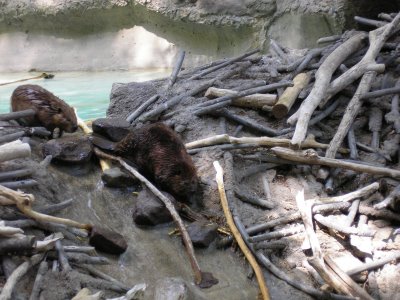


Although incidence is rare, beavers may pose a potential threat to humans
from several diseases associated with them or the habitats that they have created. Giardia limbia, a pathogenic intestinal
parasite, can be transmitted or deposited with the feces of beaver and other mammals into water systems. Drinking water supplies
(e.g., ponds, reservoirs) that have been contaminated with Giardia and lack chlorination or fine mesh filtration treatment
facilities can lead to the spread of giardiasis, an intestinal ailment that can be debilitating to those infected with the
parasite.
To reduce the potential for damage to personal property, precautions should
be taken before a beaver develops an interest in your property. As with most wildlife damage problems, no single technique
exists that will provide absolute protection from beaver depredations. However, certain measures that are initiated in a timely
fashion, maintained properly, and applied with an understanding of the habits or behaviors of beavers can reduce the likelihood
of significant damage. People residing within the beaver's range (primarily owners of shoreline property) should recognize
that beavers are clever and persistent animals and they may be able to circumvent some of the control techniques mentioned
below. Therefore, anyone affected by beavers must be willing to implement a comprehensive management strategy involving multiple
techniques.
Ro-pelŪ would be most effective when used at the first indication of beaver
presence or in areas where beavers are most actively feeding. However, as is true with many other repellents, frequent
reapplication may be required to maintain best results.
Non-lethal controls used to deter beavers can be expensive and require
substantial investment of time by a landowner to put them into use. Examples include the use of fencing and water leveling
devices.
If all attempts to deter beaver
from your land have failed, then removal of the problem animals may be necessary. Trapping, even though landowners may be
allowed to use traps to capture beaver, many individuals today are not familiar with the technology nor do they possess
the equipment and field skills necessary to be successful. Thus, trapping may best be left to professionals. As a licensed
trapper I am capable of deterring and or removing your wildlife problem.
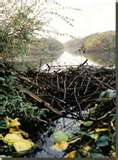
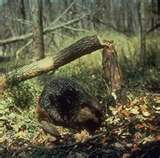
|
 |
|
|
 |
|
|
 |
|
|
|
|
|
|
 |

